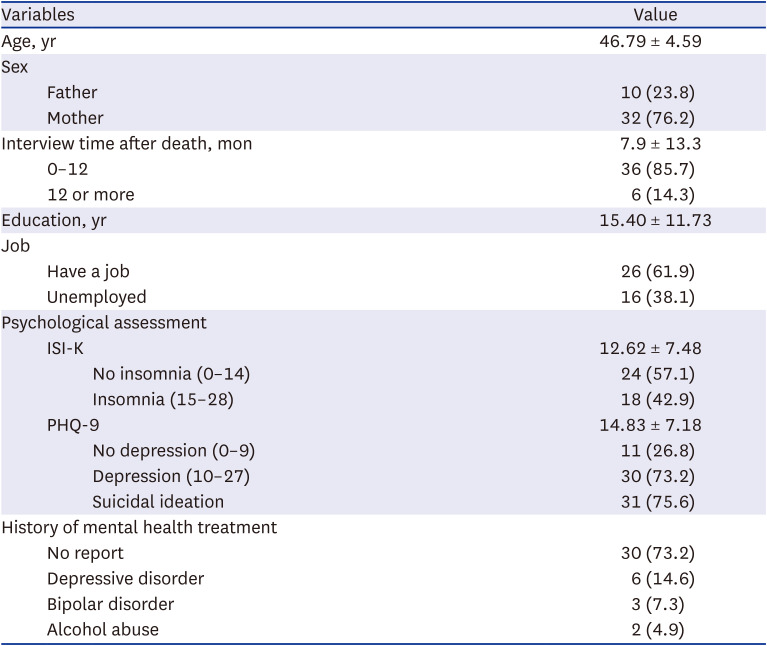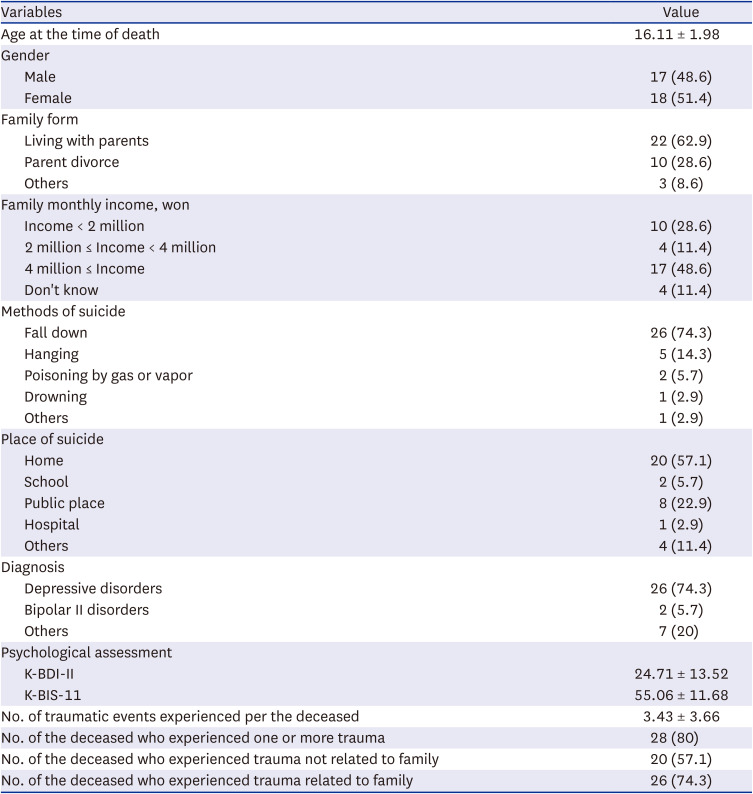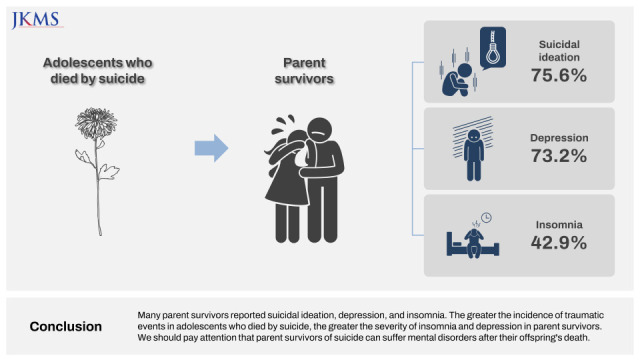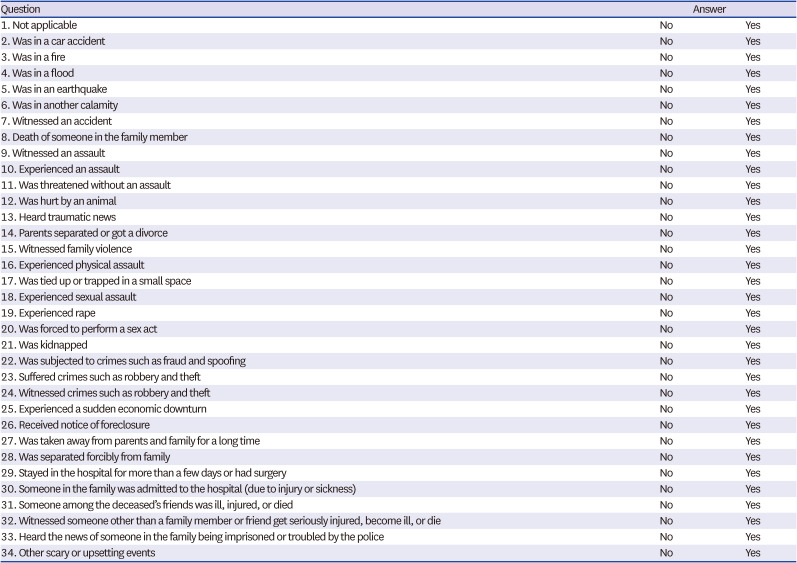1. Shain B. Committee on Adolescence. Suicide and suicide attempts in adolescents. Pediatrics. 2016; 138(1):e20161420. PMID:
27354459.
3. Andriessen K, Krysinska K. Essential questions on suicide bereavement and postvention. Int J Environ Res Public Health. 2012; 9(1):24–32. PMID:
22470275.
6. Sveen CA, Walby FA. Suicide survivors’ mental health and grief reactions: a systematic review of controlled studies. Suicide Life Threat Behav. 2008; 38(1):13–29. PMID:
18355105.
7. Ng QX, Yong BZ, Ho CY, Lim DY, Yeo WS. Early life sexual abuse is associated with increased suicide attempts: an update meta-analysis. J Psychiatr Res. 2018; 99:129–141. PMID:
29454220.
8. Omerov P, Steineck G, Nyberg T, Runeson B, Nyberg U. Psychological morbidity among suicide-bereaved and non-bereaved parents: a nationwide population survey. BMJ Open. 2013; 3(8):e003108.
9. Li N, Zhang J. Influencing factors for depression among Chinese suicide survivors. Psychiatry Res. 2010; 178(1):97–100. PMID:
20452038.
10. Mitchell AM, Kim Y, Prigerson HG, Mortimer-Stephens M. Complicated grief in survivors of suicide. Crisis. 2004; 25(1):12–18. PMID:
15384652.
11. Feigelman W, Jordan JR, Gorman BS. Parental grief after a child's drug death compared to other death causes: investigating a greatly neglected bereavement population. Omega (Westport). 2011; 63(4):291–316. PMID:
22010370.
12. Parrish M, Tunkle J. Working with families following their child’s suicide. Fam Ther. 2003; 30(2):63–76.
13. Shear K, Shair H. Attachment, loss, and complicated grief. Dev Psychobiol. 2005; 47(3):253–267. PMID:
16252293.
14. Simon NM, Shear KM, Thompson EH, Zalta AK, Perlman C, Reynolds CF, et al. The prevalence and correlates of psychiatric comorbidity in individuals with complicated grief. Compr Psychiatry. 2007; 48(5):395–399. PMID:
17707245.
15. Latham AE, Prigerson HG. Suicidality and bereavement: complicated grief as psychiatric disorder presenting greatest risk for suicidality. Suicide Life Threat Behav. 2004; 34(4):350–362. PMID:
15585457.
16. Boelen PA, Prigerson HG. The influence of symptoms of prolonged grief disorder, depression, and anxiety on quality of life among bereaved adults: a prospective study. Eur Arch Psychiatry Clin Neurosci. 2007; 257(8):444–452. PMID:
17629728.
17. Prigerson HG, Bierhals AJ, Kasl SV, Reynolds CF 3rd, Shear MK, Day N, et al. Traumatic grief as a risk factor for mental and physical morbidity. Am J Psychiatry. 1997; 154(5):616–623. PMID:
9137115.
18. Milic J, Saavedra Perez H, Zuurbier LA, Boelen PA, Rietjens JA, Hofman A, et al. The longitudinal and cross-sectional associations of grief and complicated grief with sleep quality in older adults. Behav Sleep Med. 2019; 17(1):31–40. PMID:
28107032.
19. Tofthagen CS, Kip K, Witt A, McMillan SC. Complicated grief: risk factors, interventions, and resources for oncology nurses. Clin J Oncol Nurs. 2017; 21(3):331–337. PMID:
28524889.
20. Mason TM, Tofthagen CS, Buck HG. Complicated grief: risk factors, protective factors, and interventions. J Soc Work End Life Palliat Care. 2020; 16(2):151–174. PMID:
32233740.
21. Jang J, Lee G, Seo J, Na EJ, Park JY, Jeon HJ. Suicidal attempts, insomnia, and major depressive disorder among family members of suicide victims in South Korea. J Affect Disord. 2020; 272:423–431. PMID:
32553386.
22. Bach SL, Molina MA, Jansen K, da Silva RA, Souza LD. Suicide risk and childhood trauma in individuals diagnosed with posttraumatic stress disorder. Trends Psychiatry Psychother. 2018; 40(3):253–257. PMID:
30156648.
23. Erlangsen A, Runeson B, Bolton JM, Wilcox HC, Forman JL, Krogh J, et al. Association between spousal suicide and mental, physical, and social health outcomes: a longitudinal and nationwide register-based study. JAMA Psychiatry. 2017; 74(5):456–464. PMID:
28329305.
24. Hawton K, Casañas I Comabella C, Haw C, Saunders K. Risk factors for suicide in individuals with depression: a systematic review. J Affect Disord. 2013; 147(1-3):17–28. PMID:
23411024.
25. Hardison HG, Neimeyer RA, Lichstein KL. Insomnia and complicated grief symptoms in bereaved college students. Behav Sleep Med. 2005; 3(2):99–111. PMID:
15802260.
26. Webb NB. Grief counseling with child and adolescent survivors of parental suicidal deaths. Jordan JR, McIntosh JL, editors. Grief After Suicide: Understanding the Consequences and Caring for the Survivors. New York, NY, USA: Routledge/Taylor & Francis Group;2011. p. 225–248.
27. Moskos M, Olson L, Halbern S, Keller T, Gray D. Utah youth suicide study: psychological autopsy. Suicide Life Threat Behav. 2005; 35(5):536–546. PMID:
16268770.
28. Gray D, Keller T, Haggard L, Rolfs B, Achilles J, Tate D, et al. Utah youth suicide study: preliminary results. Crisis. 1998; 5:11–17.
29. Portzky G, Audenaert K, van Heeringen K. Psychosocial and psychiatric factors associated with adolescent suicide: a case-control psychological autopsy study. J Adolesc. 2009; 32(4):849–862. PMID:
19027150.
30. Jeon M, Cho HN, Bhang SY, Hwang JW, Park EJ, Lee YJ. Development and a pilot application process of the Korean psychological autopsy checklist for adolescents. Psychiatry Investig. 2018; 15(5):490–498.
31. Greenwald R, Rubin A. Assessment of post-traumatic symptoms in children: Development and preliminary validation of parent and child scales. Soc Work. 1999; 9:61–75.
32. Bastien CH, Vallières A, Morin CM. Validation of the Insomnia Severity Index as an outcome measure for insomnia research. Sleep Med. 2001; 2(4):297–307. PMID:
11438246.
33. Morin CM, Vallières A, Guay B, Ivers H, Savard J, Mérette C, et al. Cognitive behavioral therapy, singly and combined with medication, for persistent insomnia: a randomized controlled trial. JAMA. 2009; 301(19):2005–2015. PMID:
19454639.
34. Cho YW, Song ML, Morin CM. Validation of a Korean version of the insomnia severity index. J Clin Neurol. 2014; 10(3):210–215. PMID:
25045373.
35. Spitzer RL, Kroenke K, Williams JB. Validation and utility of a self-report version of PRIME-MD: the PHQ primary care study. Primary Care Evaluation of Mental Disorders. Patient Health Questionnaire. JAMA. 1999; 282(18):1737–1744. PMID:
10568646.
36. Choi HS, Choi JH, Park KH, Joo KJ, Ga H, Ko HJ, et al. Standardization of the Korean version of Patient Health Questionnaire-9 as a screening instrument for major depressive disorder. J Korean Acad Fam Med. 2007; 28:114(2):–119.
37. Kaufman J, Birmaher B, Brent D, Rao U, Flynn C, Moreci P, et al. Schedule for affective disorders and schizophrenia for school-age children-present and lifetime version (K-SADS-PL): initial reliability and validity data. J Am Acad Child Adolesc Psychiatry. 1997; 36(7):980–988. PMID:
9204677.
38. Kim YS, Cheon KA, Kim BN, Chang SA, Yoo HJ, Kim JW, et al. The reliability and validity of kiddie-schedule for affective disorders and schizophrenia-present and lifetime version-Korean version (K-SADS-PL-K). Yonsei Med J. 2004; 45(1):81–89. PMID:
15004873.
39. Vasconcelos AG, Malloy-Diniz L, Correa H. Systematic review of psychometric proprieties of Barratt Impulsiveness Scale Version 11 (BIS-11). Clin Neuropsychiatry. 2012; 9(2):61–74.
40. Patton JH, Stanford MS, Barratt ES. Factor structure of the Barratt Impulsiveness Scale. J Clin Psychol. 1995; 51(6):768–774. PMID:
8778124.
41. Heo S, Kim JH, Oh J. The Korean version of the Barratt Impulsiveness Scale, 11th version: its reliability and validity. Korean J Psychol Gen. 2012; 31(3):769–782.
42. Beck AT, Steer RA, Brown GK. Beck Depression Inventory-II. 2nd ed. London, UK: Pearson;1996.
43. Sung HM, Kim JB, Park YN, Bai DS, Lee SH, Ahn HN. A study on the reliability and the validity of Korean version of the Beck Depression Inventory-II (BDI-II). J Korean Soc Biol Ther Psychiatry. 2008; 14(2):201–212.
44. Brent DA, Moritz G, Bridge J, Perper J, Canobbio R. The impact of adolescent suicide on siblings and parents: a longitudinal follow-up. Suicide Life Threat Behav. 1996; 26(3):253–259. PMID:
8897664.
45. Zhang J, Tong HQ, Zhou L. The effect of bereavement due to suicide on survivors’ depression: a study of Chinese samples. Omega (Westport). 2005; 51(3):217–227. PMID:
20814566.
46. Molina N, Viola M, Rogers M, Ouyang D, Gang J, Derry H, et al. Suicidal ideation in bereavement: a systematic review. Behav Sci (Basel). 2019; 9(5):53. PMID:
31091772.
47. Pitman A, Rantell K, Marston L, King M, Osborn D. Perceived stigma of sudden bereavement as a risk factor for suicidal thoughts and suicide attempt: analysis of British cross-sectional survey data on 3387 young bereaved adults. Int J Environ Res Public Health. 2017; 14(3):286. PMID:
28282958.
48. Bellini S, Erbuto D, Andriessen K, Milelli M, Innamorati M, Lester D, et al. Depression, hopelessness, and complicated grief in survivors of suicide. Front Psychol. 2018; 9:198. PMID:
29568278.
49. Guldin MB, Vedsted P, Zachariae R, Olesen F, Jensen AB. Complicated grief and need for professional support in family caregivers of cancer patients in palliative care: a longitudinal cohort study. Support Care Cancer. 2012; 20(8):1679–1685. PMID:
21892795.
50. Allen JY, Haley WE, Small BJ, Schonwetter RS, McMillan SC. Bereavement among hospice caregivers of cancer patients one year following loss: predictors of grief, complicated grief, and symptoms of depression. J Palliat Med. 2013; 16(7):745–751. PMID:
23697816.
51. de Groot M, Kollen BJ. Course of bereavement over 8-10 years in first degree relatives and spouses of people who committed suicide: longitudinal community based cohort study. BMJ. 2013; 347:f5519. PMID:
24089424.
52. Saarinen PI, Hintikka J, Viinamäki H, Lehtonen J, Lönnqvist J. Is it possible to adapt to the suicide of a close individual? Results of a 10-year prospective follow-up study. Int J Soc Psychiatry. 2000; 46(3):182–190. PMID:
11075630.
53. Feigelman W, Jordan JR, Gorman BS. How they died, time since loss, and bereavement outcomes. Omega (Westport). 2008; 58(4):251–273. PMID:
19435178.
54. Boelen PA, Lancee J. Sleep difficulties are correlated with emotional problems following loss and residual symptoms of effective prolonged grief disorder treatment. Depress Res Treat. 2013; 2013:739804. PMID:
23956852.
55. Shear MK. Clinical practice. Complicated grief. N Engl J Med. 2015; 372(2):153–160. PMID:
25564898.
56. Miller MA, Cappuccio FP. Inflammation, sleep, obesity and cardiovascular disease. Curr Vasc Pharmacol. 2007; 5(2):93–102. PMID:
17430213.
57. Knutson KL, Spiegel K, Penev P, Van Cauter E. The metabolic consequences of sleep deprivation. Sleep Med Rev. 2007; 11(3):163–178. PMID:
17442599.
58. Ferrie JE, Shipley MJ, Cappuccio FP, Brunner E, Miller MA, Kumari M, et al. A prospective study of change in sleep duration: associations with mortality in the Whitehall II cohort. Sleep. 2007; 30(12):1659–1666. PMID:
18246975.
59. Tomarken A, Roth A, Holland J, Ganz O, Schachter S, Kose G, et al. Examining the role of trauma, personality, and meaning in young prolonged grievers. Psychooncology. 2012; 21(7):771–777. PMID:
21557384.
60. Kwon H, Lee JS, Kim AR, Hong HJ, Kweon YS. Risk factors for suicidal ideation and attempts in adolescents. J Korean Acad Child Adolesc Psychiatry. 2018; 29(3):114–121.








 PDF
PDF Citation
Citation Print
Print






 XML Download
XML Download